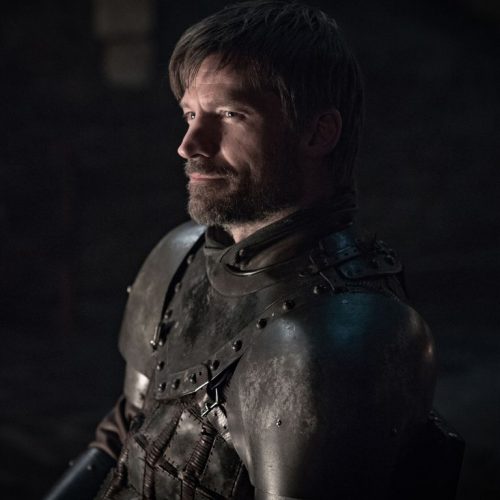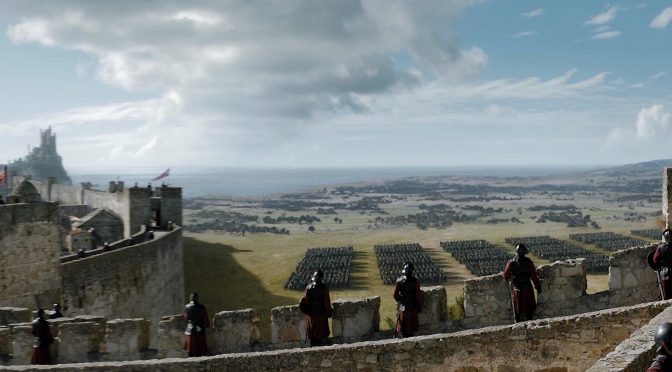Costuming the HBO series The Game of Thrones is as near a Herculean job as you’ll find in television costume design work. When HBO started production of the series in 2007, there existed a legion of fans that had been reading the book series: George R.R. Martin’s A Song of Ice and Fire, since 1996. Four books in the series had already been published and a cult was firmly established around the fantasy series.

British costume designer Michele Clapton has designed all eight seasons of The Game of Thrones (GOT) except for Season Six while she designed the series The Crown. This means that she oversaw a crew of about 70 to 100 people that worked with her at any one time. With the diversity of costumes in the Seven Kingdoms, various specialists were involved including embroiderers, dyers, leather workers, printers, fitters, cutters, sewers, armorers, metal workers, and jewelers. Any given show needed about 700 costumes, although the speaking roles got most of the attention. Along the way she has won Emmy Awards for Outstanding Costumes for Season 2, Season 4, Season 6, and Season 7. She also won an Emmy for The Crown that ran in 2017.

Almost all of the costumes were made in Belfast, close to where most of the filming was shot. Some of the arms were made in India. Much of the work was also done in Ireland. Michele Clapton told the Los Angeles Times. “We have everything on site: our armorers, our weavers, and our embroiderers. We weave our own fabric with our loom—many of the fabrics are literally made from scratch.” All types of materials are used besides fabric (and jewelry) to make up a costume. The exotic peoples and the locales they live in in the lands of Ice and Fire means that indigenous materials are used in their costumes. Items such as beads, shells, stones, crystals, and feathers are woven or sewn into the costumes. Ms. Clapton usually has a supply of such items that she has been collecting over the years, She was stumped, however, when she needed a variety of bones to accessorize the costumes of the Wildlings, especially the Lord of Bones. But she sourced the bones on eBay. Her team then molded these for reproduction and attached them using string and latex. The Wildling costumes were fabricated using hides, the parts of which were “sewn” together using latex thongs lashing the pieces together. The fur capes of Samwell Tarly and several of the Night Watch (not Jon Snow) were actually made from IKEA Skold sheepskin wool rugs.


Arms and armor are their own specialty and the costume designer must work with their makers in coming up with the total look – even for the women. And since both arms and armor become part of the most active scenes, the costume designer must work in collaboration with the stunt coordinators and sword-fight masters. Although The Game of Thrones (GOT) is a fantasy, the purpose of its costume design is the same in this as in all movies or other television dramas: the costumes are there to delineate the characters in the story, to advance the plot by setting the scene, and to help the actor feel the role they are portraying. Since GOT developed over eight seasons, the actors had plenty of time to change over the course of the story, and for some of them, to actually grow-up. The actors’ aging actually helped both the story-telling and the costume designer’s ability to help develop and portray character.


Good examples of the change of character as emphasized by costume has been seen in the leading female stars of the show. The beautiful and even sexy gowns of both Cersei and Daenerys, from the early seasons, exposed skin and shape. After the death of Drogo, Daenarys wore costumes with deep V necklines, yet she still mostly wore loose pants and boots, a sexy yet commanding figure. The boots and pants still necessary for riding horses. After her conquest of Meereen she began wearing outfits more in the style of a classical queen. In Winterfell she was obliged to wear warmer clothing, and her wardrobe changed to shades of snow and red. But as things deteriorated in the war with Cersei and King’s Landing, the Breaker of Chains turned to the Dispenser of Death, and her costume turned black.


Cersei’s form-fitting gowns in Lannister red or mauve color sets off her figure and makes her the center of attention in most every scene. But Cersei changes from King Robert Baratheon’s vindictive but unimportant Queen to a major plotter in the game of thrones. And as time marches on, her enemies grow as her victims mount up. She thus takes on a more war-like and self-protective persona. Her costumes perfectly displays this transition. But as the final season nears its end her confidence has grown to match her ego. She wears no armor or protective costume devices save her long necklace and the medallion that had been her daughter Myrcella’s. She wears it no doubt as a reminder of her need for revenge.


Sansa has made a remarkable transition, one that has been filled with sorrow and abuse. Her costumes show how she has grown and changed, from an innocent teenager to a self-assured and self-protective survivor – a learner of life’s skills and of men’s treachery. She too has learned about the game of thrones, becoming a judge of character and a leader of men. Returning as an heir of the House of Stark and as Lady of Winterfell, she is in a position of command, vying with Daenerys for control of the North. Her costume reflects both the tradition of the Starks with the ample use of fur capes (the Dire Wolf is the house sigil) and the obvious need for warm outfits. Her costumes in the final three seasons are accessorized by a necklace composed of a large ring and chain, forming an aiguillette. The ring represents her wholeness forged out of her former enchainment.


The fur cape style is shared by Jon Snow (though now becoming Aegon Targaryen). His costumes have been shaped by his days at the Wall – amidst all black-clad men nicknamed the crows, with heavy fur collars and capes. This last feature had become almost a standing joke on the set. Whereas several cast members really liked their costumes and some wanted to keep them. Kit Harrington as Jon stated he never wanted to see his furs again.

Arya, the younger Stark girl, was always the tom-boy. Her survival skills were a strong instinct that led her from one life-learning skill to another as she escaped from danger to danger. She first escaped the tragedies at King’s Landing and then assumed a boy’s urchin costume for disguise. She wore the costume through several seasons. Her one steady accessory was her short sword Needle. She learned to fight in her early fencing lessons and her lessons in death learned from Jagen H’gar at the House of Black and White, the home of faceless men. Maisie Williams as Arya was thrilled to be finally out of her tom-boy costume and into different costumes. And once back to Winterfell, she had a proper costume befitting her stature, now not only accessorized with Needle but with a dagger made of deadly valyrean steel. But wherever she goes she never seems to get far from Sandor Clegane, alias the Hound. sometimes her tormentor, sometimes her protector, Arya has not grown large but with acquired skills she has dispensed “frontier” justice. Together they make a perfect odd travelling couple, only separated near the very end. Yet she is the ultimate avenger, and the woman of many faces.


The men of GOT are almost all a lusty and warlike bunch. Their costumes reflect their station, place of origin, and their combat readiness at any given time. As in the real armies of the ancient world, they are meant to look terrifying. In those days when combat was almost always hand-to-hand, you often stared at your enemy up-close and had time to become afraid – or confident. Your military costume helped you become more confident. Padding and armor protected you and made you look bigger. Heavy boots not only protected their feet but planted them solidly on the territory they defended or conquered. Shoulder armor made you look stronger. Swords, axes, bows, spears, and spikes showed the opposing side how they would be wounded or killed. Colorful banners with household sigils served as rallying points and showed the other side the powerful enemies they were dealing with. Even outside of combat, the men of rank wore their swords. Their costumes were festooned with leather straps and belts, with exaggerated V-lines in the angle of their torsos. Such a silhouette has been used down to the comic superheroes of today.
Today’s costume designers not only have to design and produce appropriate, character-building costumes for the cast, once they’re made they have to beat them up. Any male costume (with few exceptions) has to look like its been worn in the field for some time. So the costuming staff has to abrade, cut, tear, and even make visually noticeable repairs. Painters also add fading and wear marks to textiles to make them appear old.

The men of mystery, such as Varys, Peter Baelish and the Maesters wear different costumes than men of arms. Varys the spymaster or Master of Whisperers, served whomever was in power (but always for the greater good of the realm) often vying for influence with Peter Baelish, which he eventually won. He sided with Daenerys along with Tyrion. His costumes reflect a somewhat exotic but simple look, having been born across the Narrow Sea in Lys. His posture was usually to place his hands in his long wide sleeves, traditional Chinese style. This denotes that he not only doesn’t need his hands for work or for combat, but that his doings are mysterious as well. One never knows what he has up his sleeve, or what ring he wears on his finger. Peter Baelish considers himself important with no office high enough for his ambitions. He usually wears a dark belted tunic. The tunic is invariably high-necked, symbolically protecting his throat. The Maesters are scholars and men of learning. They wear heavy monk-like cloaks with heavy metal chains around their necks, each of the metals is different indicating their particular scholarly expertise. There is also a woman of mystery, Melisandre, the Red Priestess. Her costume is invariably a red gown that she once wore with deep decollete, or a long red robe to match her red hair. She is the priestess to the Lord of Light.

The Game of Thrones has been so very complex and so very rich in so many ways. Set aside that as George Martin stated, it really would have taken several more seasons to properly finish the story. The costume designer and staff accomplished their job with high skill and flair. They took us on a journey around the world of the Seven Kingdoms and beyond, having us believe in the peoples that inhabited those worlds, and no doubt had the actors believing in them too as they dressed the part – the true role of the costume designer. And as the costumes served their purpose we are lucky that they were not discarded as in the studio days of old. But instead they have been kept for the archives and have been exhibited as they will continue to be. So we can have the chance perhaps to admire up close the art and craft that fueled our fantasy for so many years.
- All photos by Helen Sloan
Views: 2200

